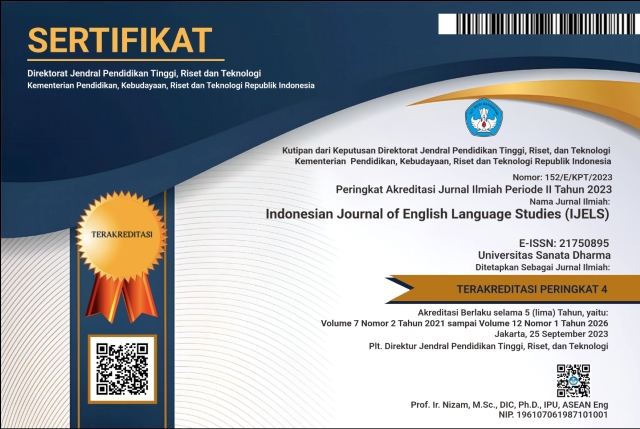Phonological Processes in Chagga Nativized Lex-emes Borrowed From Standard Swahili: A Chagga - English Comparative Study
Abstract
Linguistics as a present study, acts as an instrument towards promoting local languages. This recent study aims at studying some of phonological processes in Chagga language (Particularly Kibosho and Marangu varieties). Chagga is a Bantu language family spoken by Chagga people of Tanzania, south of Mount Kilimanjaro. Borrowing is the act of taking a word or a phrase from one language and used it in another language. The present study is carried out under Generative CV Phonology Theory, developed by linguists, Keyser and Clements in (1983). This theory strives to guide the present study on scrutinize phonological processes with their rules in Kibosho and Marangu varieties. The very study is the phonological type of study which employs qualitative method. The study employs Interview to observe the pronunciation by native speakers, voice note as linguistic variable need for homogenous resemblance of the uttered lexical items and the phonological processes. To answer study question one the study observes there are three major causes of phonological processes in Chagga as in English with very little variations namely: Phonological processes motivated by syllable structure rules [vowel insertion/ epenthesis], Phonological processes in Chagga language affecting syllable [consonant deletion] and Phonological processes motivated by phonemic reasons [cluster tolerance, feature change]. In adhering problem two the study has found similar phonological processes between English and Chagga with very little differences especially on phonemes which undergo the changes hence advocates for further analyses in local African and Asian languages to pursue a similar study or any nearly phonological study in order to preserve and promote local linguistics contents from ones native language.
Keywords: Phonological processes, Nativazation, Phonological rules, Chagga languageI
Full Text:
PDFReferences
Ali, A.Z. (2012). A Phonological Study of English and Arabic Assimila-tion: A Contrastive study. Journal of College of language (25), 148-172
Berry, Anita, K. (2002). Linguistics Per-spectives on Language and Ed-ucation. New York: Green-wood.
Chomsky, N. & Halle, M. (1968). The sound pattern of English. New York: Harper & Row Publish-ers
Chomsky, N. (1957). Syntactic Struc-tures. The Hague. Mouton
Clements, G. & S. J. Keyser (1983). CV Phonology: A Generative Theory of the Syllable.
Dirvan, R. (2004). Cognitive Explora-tion of Language and Linguistics. London: University of Duisburg.
Duanmu, S. (2009). Syllable Structure. The Limits of Variation. Oxford: Oxford University Press.
Elly Van Gelderen (2006). A History of the English language. London: John Benjamins Publishers.
Fisher, T. (2012). Chagga Elites and the Politics of Ethnicity in Kilimanja-ro, Edinburgh. The University of Edinburgh.
Gardner, W.(2012). Toward Transcu tural Training in Phonological Processes for Bantu Lan-guage: Mother Tongue Transla-tor.
Guthrie, M. (1948). The classification of Bantu languages. London: Oxford University Press.
Guthrie, M. (1967-1971). Comparative Bantu: An introduction to Com-parative Linguistic and Prehistory of Bantu languages. Farnborough: Gregg Press.
Heine, D & Philippson, G. (2003). The Bantu Languages. New York: RoutledgePublishers.
Hoffer, B. (2005). Language Borrowing and the Indices of Adaptability and Receptivity, Trinity University Press.
Hyman, L. (1975). Phonology: Theory & Analysis. London: Holt- Rinne-hert and Winston.
Kenstowicz, M. (1994). Phonology in Generative Grammar, Blackwell Textbooks in Linguistics. Cam-bridge, MA: Basil Blackwell. Languages: An introduction. Cambridge: Cambridge University Press.
Ladefoged, P. (2006). A Course in Pho-netics. Boston: Thomson Wadsworth.
Lema, A. A. (1973). The Impact of the Leipzig Lutheran Mission on the People of Kilimanjaro: Dar es Sa-laam: University of Dar es Salaam.
Mahlangu, K. (2007). Adoption of loan-words in Ndebele. University of Pretoria.
Massamba, D. (2010). Phonological Theory: History and Development, Dar-es-salaam: Institute of Swahi-li.
Massamba, D.P.B. (1991). Phonological theory: History and development. Dar es Salaam: Dar es Salaam University Press.
Mushi. M. (2005). Endangered African Proverbs Collections: A continua-tion of the African Proverb Pro-ject. Arusha, Tanzania, CNET global inc.
Mutua, N (2007). A constraint-based analysis of Kikamba nativized loanwords, Nairobi: University of Nairobi
Mwaliwa, H (2014). An Analysis of the Syllable Structure of Standard Kiswahili Loanwords from Mod-ern Standard Arabic, Nairobi: The University of Nairobi.
Mwihaki, A.N. (1998). Loanword nativ-ization: A generative view of the phonological madaptation of G?k?y? loanwords. Nairobi: Ken-yatta University.
Mwita, L.C. (2009). The adaptation of Swahili loanwords from Arabic: A constraint based Analysis. The journal of Pan African studies, vol.2, no.8, 46-60. Retrieved http://www.jpanafrican.com/docs/vol2no8/2._Adaptationofswahililoanwords. Pdf
Nathan, G. (2008). Phonology; A Cog-nitive Grammar Introduction. USA. Routledge.
Newman, P. (2000). Comparative Lin-guistics. In D. Nurse and B. Heine (eds.) African
Nurse, D. and Philippson, G. (1977). Tone in Old Moshi (Chagga).Dar es Salaam. The University of Dar es Salaam
Oden, D (2005) Introducing Phonology. New York: Cambridge University Press.
Peter T & Chilling, N. (2001). Hand-book of Sociolinguistics. Oxford: Bazil Blackwell.
Roach, P. (2002). English Phonetics & Phonology; A practical Course. Cambridge: Cambridge University Press.
Schane, A. (1973). Natural Rules in Phonology. In R.P Stockwell & Ronald K. S Macaulay Linguistic Change and Generative Theory. Bloomington: Indiana University Press.
Tsvetkov, Y, Ammar, W &Dyer, C (2005). Constraint-Based Models of Lexical Borrowing. Carnegie Mellon University. USA. Pitts-burgh.
Trask, R. L. (1996). A Dictionary of Phonetics & Phonology. London: Routledge. Pp.296.
Ziegler, J & Goswami, U. (2005). The effects of spelling consistency on phonological awareness: A com-parison of English and German.
Zivenge, W (2009). Phonological and Morphological Nativization of English Loans in Tonga. Universi-ty of South Africa.
DOI: https://doi.org/10.24071/ijels.v4i1.1635
Article Metrics
Abstract view : 2068 timesPDF view: 1583 times
Refbacks
- There are currently no refbacks.
IJELS Journal Sinta 4 Certificate (S4 = Level 4)
We would like to inform you that Indonesian Journal of English Language Studies (IJELS) has been nationally accredited Sinta 4 by the Ministry of Education, Culture, Research and Technology of the Republic of Indonesia based on the decree No. Surat Keputusan 152/E/KPT/2023. Validity for 5 years: Vol 7 No 2, 2021 till Vol 12 No 1, 2026
IJELS e-ISSN 2715-0895; IJELS p-ISSN 2442-790X
Indonesian Journal of English Language Studies (IJELS) is published twice a year, namely in March and September, by the English Language Studies (ELS) of the Graduate Program of Sanata Dharma University, Yogyakarta, Indonesia.


 IJELS p-ISSN:
IJELS p-ISSN: 









